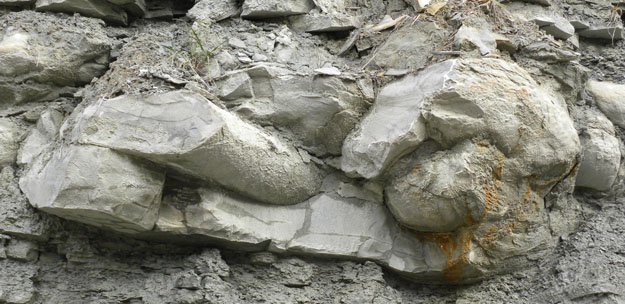MAYSVILLE, KENTUCKY–Strong earthquakes produce seismic waves which can do much damage on land, as we well know. They can also disturb unconsolidated sediments on shallow oceanic shelves and platforms, producing characteristically swirled structures called seismites. The Upper Ordovician outcrop we visited today has three horizons of well-preserved seismites associated with those strange blocks described previously.

The "ball-and-pillow" structures in this view of the Kentucky Route 11 outcrop of the Fairview Formation are seismites produced by Late Ordovician earthquakes. There are two seismite horizons visible here, each with a flattened top produced by later erosion and redistribution of the sediments by oceanic currents.

Closer view of a seismite in the Kentucky Route 11 outcrop. ( I couldn't reach this high to place my hammer for scale; the structure is about a meter thick.)
The earthquakes which caused these seismites were probably associated with orogenic (mountain-building) activity to the east where the present (and much later) Appalachian Mountains sit. Careful measurement and mapping of seismites can tell us much about the specific locations and magnitudes of these earthquakes, as well as the consistency of the sediments they disturbed long ago on those ancient seafloors.



Mark –
Are there ways to form ball-and-pillow structures (at about that scale) that aren’t related to earthquakes? I’m asking because we’ve got some very similar-looking sedimentary structures in Durango (near the bottom of the Cretaceous Mesa Verde Group), and I’ve never heard anyone interpret them as seismites before. Are there other things we could look for to test whether these ball-and-pillow structures are related to earthquakes? (I’m thinking that this might make an interesting undergraduate research project.)
Kim Hannula
Fort Lewis College
Hello Kim!
Yes, there certainly are ways to make similar ball-and-pillow structures. The most prominent is dewatering of sediments by overpressure (which is what these Ordovician features were previously attributed to). Another would be slumping of partially-consolidated muds. The main reason these Kentucky structures are now thought to be seismites is their widespread distribution in a tight time interval — they are virtually marker beds. That would be unlikely for dewatering or slumping, which would be more local and diachronous. (There are also contorted beds like these which may be associated with meteorite impacts. Wouldn’t that be cool?)
The structures you note at the base of the Mesa Verde Group sound like excellent subjects for undergraduate research. You and your students could follow them stratigraphically, although you probably don’t have the detailed biostratigraphic controls present in the highly fossiliferous Ordovician beds.
Good luck. Love to hear about what you find!
Meteorite beds might be determined by glassy microspherules, some are 1/8 the size of a human hair, others as big as mustard seeds or bigger. Hope this helps the undergrad project.
Thanks, Angelle!